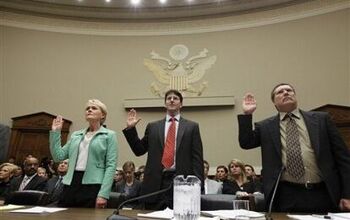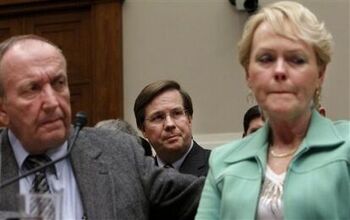The Toyota Testimony, Day One: A Comedy In Three Parts: Part Three: The Inevitable Punchline
After a big buildup by expert witnesses, and Toyota’s Jim Lentz’s evasion of any evidence that his firm’s cars are afflicted with an untraceable electronic gremlin, the House Energy Committe turned its attention to Secretary of Transportation Ray LaHood. Because LaHood’s department falls under the congress’s oversight (and carries the government’s ultimate responsibility for the safety of American motorists), LaHood might well have been the main focus of the committee’s investigation. And indeed his last-in-line billing appears to make him the event’s headliner. Or at least it would have if his testimony didn’t make the previous several hours of Ahab-ing largely unnecessary, and possibly even highly embarrassing.
Because committee members had to vote on the house floor, yesterday’s evening session was divided into two parts, the first of which saw LaHood deliver his eight-page prepared statement and the second of which was devoted to questions and (to a lesser extent) answers. The contrast between the two was marked.
LaHood’s prepared statement is a workmanlike document, which describes the NHTSA’s actions in relation to Toyota’s unintended acceleration scandal without resorting to the scaremongering of the previous two sessions. Contrary to reports from State Farm Insurance, which claims it warned the NHTSA of Toyota’s troubling UA statistics as early as 2004, LaHood’s testimony makes it clear that it opened its first investigation in March of 2007. That investigation led to Toyota’s recall of floormats in September 2007, and when another accident took place, it urged Toyota to once again contact consumers about the recall, which it did. When the NHTSA found that certain Toyota pedal designs might be prone to entrapment, it urged Toyota to perform another recall, which it did in October 2009.
Though LaHood said the NHTSA was investigating Toyota’s timeliness in announcing its recalls (results pending), he indicated that Toyota had largely complied with his agency’s requests:
Even after the NHTSA Administrator issues an order directing a recall, the manufacturer can avoid doing the recall until NHTSA proves its case in court. In such a case, the agency has the burden of proving by a preponderance of the evidence that a vehicle defect exists and that it creates an unreasonable risk to safety. As a result, recalls occur most quickly when a manufacturer announces the recall without waiting for NHTSA to open and complete an investigation. That is what happened here — because of the pressure NHTSA applied.
In short, while Lentz was able to evade the committee’s main goal (evidence of mysterious electronic defects), LaHood actually helped mitigate the committee’s secondary concerns, namely that Toyota dragged its heels on recalls to the point of criminality. In the matter of the CTS pedal stickiness, LaHood once again confirmed that Toyota had been able to self-report and announce a recall before an NHTSA investigation had been launched (although a separate timeliness inquiry has been launched into this issue as well).
But LaHood’s exoneration of Toyota wasn’t left there. In the section of his testimony labeled “other instances of unintended or excessive acceleration,” LaHood notes:
The information NHTSA has received from consumers concerning unintended or excessive acceleration in vehicles can be divided into general categories that include: engine surging that lasts only a second or two; unintended acceleration from a stopped position or very low speed that results in quick movement over a short distance and sometimes results in crashing into an object; and events that begin at high speeds because the driver intended to accelerate quickly and continue for a sustained period of many minutes beyond what the driver intended. The possible causes of these events that NHTSA has been able to identify include mechanical problems with the accelerator; obstruction of the accelerator by another object; or human error (pressing the pedal)… for the high-speed events that last for many seconds or minutes, the only cause NHTSA has been able to establish thus far is entrapment of the pedal by a floor mat. The only exception to this has [sic] may have been a recent event in New Jersey that apparently did not involve floor mat entrapment but apparently did involve a stuck CTS pedal… with one exception, NHTSA has not been able to establish a vehicle-based cause for unintended acceleration events in Toyota vehicles not covered by those two recalls. The exception was a recall of model year 2004 Sienna vans in 2009 due to a defective trim problem that could, if loosened during servicing, entrap the accelerator at full throttle
With these issues established, LaHood had essentially let Toyota off the hook… at least until the ongoing investigation into “all possible defects in [Toyotas] vehicles that may be causing unintended acceleration” concludes. LaHood’s only mistake in clearing the record on Toyota’s behavior: it left him and his agency dangling alone on the committee’s hook.
Inevitably then, LaHood was asked if he and his agency bore some responsibility for the current scandal. His response showed that he hadn’t lost any of the experience he gained while serving on the other side of congressional inquiries [LaHood served as a representative of Illinois from 1994 until 2008]. From folksy cliches (“we will get into the weeds on electronics”) to use of the third person (“no one has talked more about safety in Washington DC than Ray LaHood”) to irrelevant examples of his commitment to the concept of safety (“we held a summit on distracted driving”), LaHood fought political posturing with political posturing. And because congress is ultimately responsible for NHTSA’s funding and oversight, he largely got away with it [with one major exception to be explored in a forthcoming post].
In addition to more general grandstanding, there are three legs to the bureaucrat’s stool: blaming predecessors, not being able to comment on ongoing investigations, and blaming a lack of funding. Unsurprisingly, LaHood brought each of these canards to bear on his questioners. LaHood admitted that the agency had come up short in the past (an admission based on the possibility that an undiscovered e-gremlin is still lurking in the background), and held up President Obama’s decision to add 66 new investigator positions to NHTSA and the possibility of further funding increases as a solution to future embarrassment.
As the questioning pounded away, LaHood retreated further and further into these self-protection measures. Though a note of shrill defensiveness crept into his voice, his positions didn’t change and other than an single, ominously dangling sentence (“I’m not going to trash Toyota’s North American leadership”) he didn’t indicate any damning malfeasance on Toyota’s part. After weeks of media speculation, and three witnesses worth of fearmongering, visions of damning evidence of Toyota malfeasance or NHTSA complicity in a coverup were all but buried by the time the questions ended. And in the grand tradition of theatrical farce, the hunter ended up hunting himself.
Congress holds hearings like these to uncover shocking evidence and to impress its constituents with its dedication to their safety and well-being. Having been enticed into believing that sinister conspiracies exist in Toyota’s software code and the halls of the NHTSA, the House Energy Committee uncovered only one actionable solution to the ongoing scandal: greater funding for NHTSA’s investigative capabilities. Put differently, after hours of posturing congress finally met the enemy and he was them.
More by Edward Niedermeyer
Latest Car Reviews
Read moreLatest Product Reviews
Read moreRecent Comments
- MaintenanceCosts E34 535i may be, for my money, the most desirable BMW ever built. (It's either it or the E34 M5.) Skeptical of these mods but they might be worth undoing.
- Arthur Dailey What a load of cow patties from fat cat politicians, swilling at the trough of their rich backers. Business is all for `free markets` when it benefits them. But are very quick to hold their hands out for government tax credits, tax breaks or government contracts. And business executives are unwilling to limit their power over their workers. Business executives are trained to `divide and conquer` by pitting workers against each other for raises or promotions. As for the fat cat politicians what about legislating a living wage, so workers don't have to worry about holding down multiple jobs or begging for raises? And what about actually criminally charging those who hire people who are not legally illegible to work? Remember that it is business interests who regularly lobby for greater immigration. If you are a good and fair employer, your workers will never feel the need to speak to a union. And if you are not a good employer, then hopefully 'you get the union that you deserve'.
- 28-Cars-Later Finally, something possibly maybe worth buying.
- EBFlex The simple fact is very small and cheap ICE vehicles have a range thats longer than all EVs. That is the bar that needs met. And EVs cannot meet that.Of course range matters. But that's one element of many that make EVs completely ineffective at replacing ICE vehicles.
- Wolfwagen I like the exterior mods short of the satellite dish. Put a normal interior in it and they could have sold it as some sci-fi movie trim


































Comments
Join the conversation
"add 66 new investigator positions to NHTSA and the possibility of further funding increases as a solution to future embarrassment." Yeah, because we don't want the NHTSA to be embarrassed. What could possible be worse, other than risking the public safety on the roads or a manufacturer not acting quickly enough to fix a potentially lethal design problem (software or otherwise). Why 66 people? Why not 50 or 150 or 10. Why not hire engineers rather than 'investigators'? This is such nonsense, and it gives fuel to those like me who continue to believe that the only thing worse than corrupt private enterprise is having the same people running corrupt government programs.
To me, the summary doesn't quite match up with the opinion of the article. I don't think he let Toyota off the hook at all, but did implicate the NHTSA. I don't think the State Farm comment makes sense. If the NHTSA didn't look into what State Farm told them, in 2004, it is the NHTSA's fault for doing so. "Contrary to reports from State Farm Insurance, which claims it warned the NHTSA of Toyota’s troubling UA statistics as early as 2004, LaHood’s testimony makes it clear that it opened its first investigation in March of 2007." Did State Farm say that the NHTSA opened an investigation? I am not sure why the word contrary is appropriate. It sounds like the NHTSA ignored the data, making the NHTSA more culpable. Also, what doesn't seem to have been discussed is the negotiating of the recalls. I would like to know more about this form the NHTSA and from the automotive industry. Were statistics about UA complaints brought up? I would find it hard to believe that anyone would think that Toyota drivers are 10 times less likely to know how to control a vehicle than GM drivers. Why didn't Toyota recall the CTS pedal initially when it thought there was a design problem in 2007? Why didn't the NHTSA do the same when they found out about the issue? Were these questions asked? Were questions asked of Lentz regarding the service records of UA to the dealers? I mean, I assume somewhere Toyota has a database of problems reported. Would be interesting to know how that data was used. Oh, only if they allowed some people who have looked up some history on this issue ask some questions.